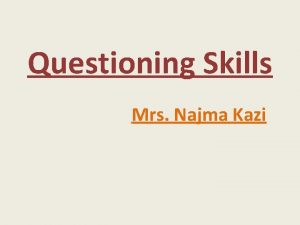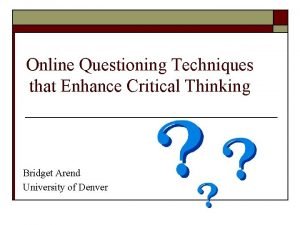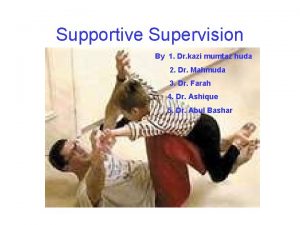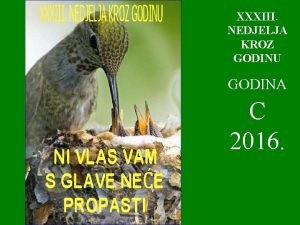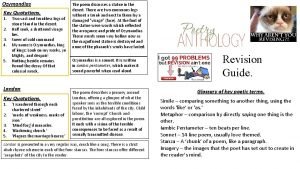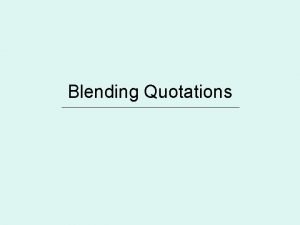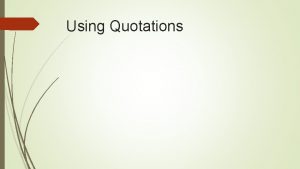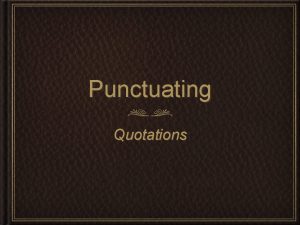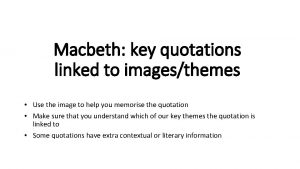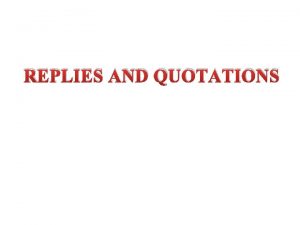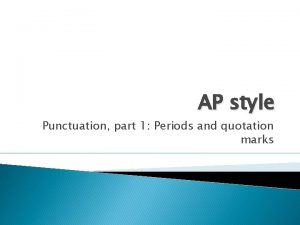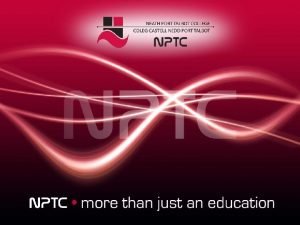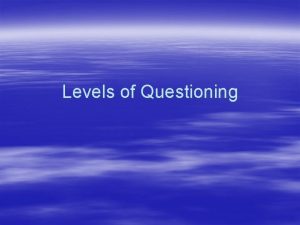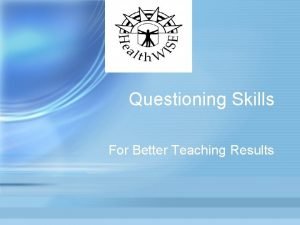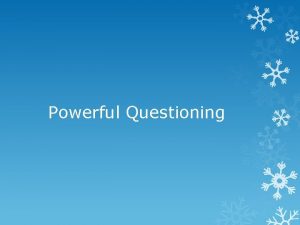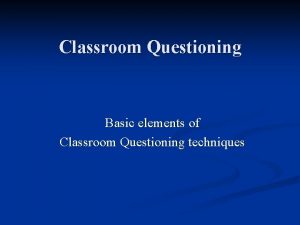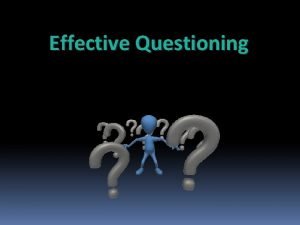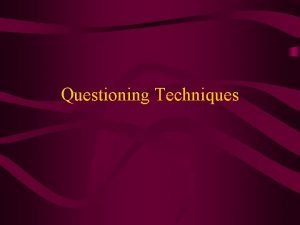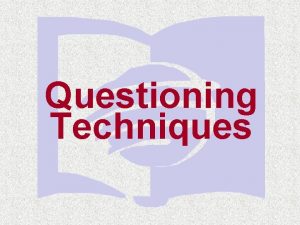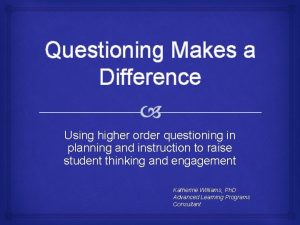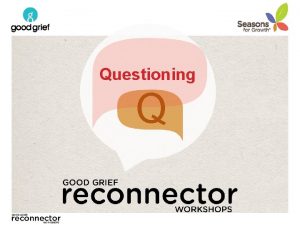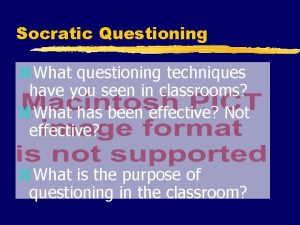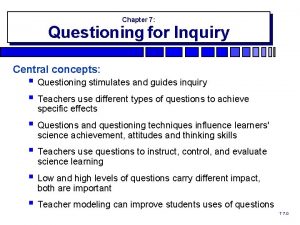Questioning Skills Mrs Najma Kazi v Quotations A































- Slides: 31

Questioning Skills Mrs. Najma Kazi

v. Quotations • "A good question is never answered. It is not a bolt to be tightened into place but a seed to be planted and to bear more seed toward the hope of greening the landscape of idea. " • To question well is to teach well. In the skillful use of questions, more than anything else, lies the fine art of teaching.

v. Importance of Questioning in Teaching Learning Process: As per Government G. R. dated 20 Aug. 2010. 1) Teachers are expected to prepare question paper at this level. Papers prepared by external agency should not be used. 1) Teachers questioning skills need to be developed. 2) Teachers are expected to continue preparing new questions to add to the question bank. 3) The open ended questions as far as possible. 4) Question which demand. creative responces. 5) Prepare questions based on varity of objectives like knowledge, application, understanding, skill, interest, apprciation. etc. 6) Question based on not learning mechanical reply should not be encouraged.

v. Open & Closed Ended Questions A closed ended question(CEQ) can be answered with either a single word or a short phrase. An open ended question(OEQ) is likely to receive a long or multiple answers. Characteristics : *CEQ give us facts , are easy & quick to answer, & keep control of the conversation. *OEQ ask respondent to think & reflect, give opinions & feelings, & take control of the conversation.

v. Features of Open Ended Questions No fixed method No fixed answer/Many possible answers Solved in different ways & on different levels Offer student room for own decision making & natural mathematical way of thinking • Develop reasoning & communication skills • Open to student’s creativity & imagination • Focuses on student’s understanding & ability to reason & apply knowledge • •

v. Things to remember while preparing questions: 1)Read the content thoroughly 2) Decide the types of questions to be prepared 3) Prepare the blue print for proper distribution of weightage 4) Generate questions as per the type & weightage decided 5) Classify the questions as per the given tables

Blue Print of Question Paper Class: Sr. no. 1. 2. 3. 4. 5. 6. Total (without options) Total (with Name of the topic Subject: Q. 1 (A) Q. 1 (B) Q. 2 (A) Q. 2 (B) Q. 2 (C) Q. 3 (A) Q. 3 (B) Q. 3 (C) Chapter wise Total with options

Table No. 1 q. Classification as per Question type Objective type Questions Short Answer Questions Long Answer Questions Table No. 2 q. Classification as per the Objectives Knowledge Understanding Application Skill Synthesis Analysis Evaluation

Table No. 3 ØClassification as per Characteristics Open Response Values Core Component Life Skills Table No. 4 ØSummarising tables 1, 2 &3 Objective Question type Question No. Characteristics

Learning should inculcate… LIFE SKILLS CORE COMPONENTS OF NPE 1986 VALUES Self-awareness India’s Freedom Movement Punctuality Empathy The constitutional obligations Neatness Problem solving Nurturing national identity Dignity of labour Decision Making India’s common cultural heritage Gender Equality Effective Communication Equality, democracy & Secularism Scientific Attitude Interpersonal relations Gender Equality National Integration Creative thinking Protection of the environment patriotism Critical thinking Removal of Social Barriers Sensitivity Coping with emotions Small family norms Religious Tolerance Coping with stress Scientific Temper Courtesy

v. Three Aims of Questioning • Increasing Attainment • Enhancing retention • Encouraging participation

v Purpose of Questioning: • They can help the teacher gauge how effectively pupils are learning • They can assist the teacher in forward planning • They can be used to involve pupils in on-going classwork • They can give pupils opportunities to articulate their understanding • They should give opportunities for successful answers, but should also provide challenge • Pupils’ communication skills & Social skills can also be improved

v Purpose of Questioning: • Pupils can be invited to ask questions themselves, which can lead to more sophisticated discussions • To develop interest and motivate students to become actively involved in lessons • To evaluate students' preparation and check on homework or seatwork completion • To develop critical thinking skills and inquiring attitudes • To review and summarize previous lessons

v. TYPES OF QUESTIONS v Open questions • These are useful in getting another person to speak. They often begin with the words: What, Why, When, Who • Sometimes they are statements: “tell me about”, “give me examples of”. • They can provide you with a good deal of information. v Closed questions • These are questions that require a yes or no answer and are useful for checking facts. They should be used with care - too many closed questions can cause frustration and shut down conversation. v Specific questions • These are used to determine facts. For example “How much did you spend on that” v Probing questions • These check for more detail or clarification. Probing questions allow you to explore specific areas. However be careful because they can easily make people feel they are being interrogated

TYPES OF QUESTIONS v Hypothetical questions • These pose a theoretical situation in the future. For example, “What would you do if…? ’ These can be used to get others to think of new situations. They can also be used in interviews to find out how people might cope with new situations. v Reflective questions • You can use these to reflect back what you think a speaker has said, to check understanding. You can also reflect the speaker’s feelings, which is useful in dealing with angry or difficult people and for defusing emotional situations. v Leading questions. • These are used to gain acceptance of your view – they are not useful in providing honest views and opinions. If you say to someone ‘you will be able to cope, won’t you? ’ they may not like to disagree.

Bloom’s Taxonomy of Learning • According to Benjamin Bloom, and his colleagues, there are six levels of cognition: • Knowledge: rote memorization, recognition, or recall of facts • Comprehension: understanding what the facts mean • Application: correct use of the facts, rules, or ideas • Analysis: breaking down information into component parts • Synthesis: combination of facts, ideas, or information to make a new whole • Evaluation: judging or forming an opinion about the information or situation

v. Bloom’s Taxonomy • Taxonomy of Cognitive Objectives • 1950 s-developed by Benjamin Bloom • Means of expressing qualitatively different kinds of thinking • Adapted for classroom use as a planning tool • Continues to be one of the most universally applied models • Provides a way to organisethinking skills into six levels, from the most basic to the higher order levels of thinking • 1990 s-Lorin. Anderson (former student of Bloom) revisited the taxonomy

Changing Terminology Original Terms • • • Evaluation Synthesis Analysis Application Comprehension Knowledge New Terms • • • Creating Evaluating Analysing Applying Understanding Remembering

Different Types of Questions based on Bloom's Taxonomy Ø Lower Order Knowledge (Remembering) These types of questions test the students’ ability to memorize and to recall terms, facts and details without necessarily understanding the concept. Key Words: Memorize, Define, Identify, Repeat, Recall, State, Write, List & Name Ø Comprehension (Understanding) These questions test the students’ ability to summarize and describe in their own words without necessarily relating it to anything. Key Words: Describe, Distinguish, Explain, Interpret, Predict, Recognize & Summarize

Different Types of Questions based on Bloom's Taxonomy • Higher Order Application (Transferring) Application questions encourage students to apply or transfer learning to their own life or to a context different than one in which it was learned. Key Words: Apply, Compare, Contrast, Demonstrate, Examine, Relate, Solve & Use • Analysis (Relating) These questions encourage students to break material into parts, describe patterns and relationships among parts, to subdivide information and to show it is put together. Key Words: Analyze, Differentiate, Distinguish, Explain, Infer, Relate, Research & Separate

Different Types of Questions based on Bloom's Taxonomy • Synthesis (Creating) These questions encourage students create something new by using a combination of ideas from different sources to form a new whole. Key Words: Arrange, Combine, Create, Design, Develop Formulate, Integrate & Organize • Evaluation (Judging) Evaluation questions encourage students to develop opinions and make value decisions about issues based on specific criteria. Key Words: Assess, Critique, Determine, Evaluate, Judge, Justify, Measure & Recommend

Bloom’s Taxonomy-Sample Questions Knowledge Useful Verbs • • • List Locate Name Recognize State Describe Recall Repeat Retrieve Sample Question Stems • • • What happened after. . . ? How many. . . ? Who was it that. . . ? Can you name the. . . ? Describe what happened at. . . ? Who spoke to. . . ? Can you tell why. . . ? Find the meaning of. . . ? What is. . . ? Which is true or false. . . ?

Bloom’s Taxonomy-Sample Questions Understanding Useful Verbs • • • Conclude Define in your own words Predict Tell Identify paraphrase Summarize Categorize Match Sort Compare Contrast Sample Question Stems • • • Can you write in your own words. . . ? Can you write a brief outline. . . ? What do you think could of happened next. . . ? Who do you think. . . ? What was the main idea. . . ? Who was the key character. . . ? Can you distinguish between. . . ? What differences exist between. . . ? Can you provide an example of what you mean. . . ? Can you provide a definition for. . . ?

Bloom’s Taxonomy-Sample Questions Applying Useful Verbs • • • Generalize Infer Show Use Solve Illustrate Examine Classify Construct Sample Question Stems • Do you know another instance where. . . ? • Could this have happened in. . . ? • Can you group by characteristics such as. . . ? • What factors would you change if. . . ? • Can you apply the method used to some experience of your own. . . ? • What questions would you ask of. . . ? • From the information given, can you develop a set of instructions about. . . ? • Would this information be useful if you had a. . . ?

Bloom’s Taxonomy-Sample Questions Analyzing Sample Question Stems Useful Verbs • • • Distinguish Select Arrange Organize Outline Examine Compare Investigate Explain • • • • Which events could have happened. . . ? If. . . happened, what might the ending have been? How was this similar to. . . ? What was the underlying theme of. . . ? What do you see as other possible outcomes? Why did. . . changes occur? Can you compare your …with that presented in. . . ? Can you explain what must have happened when. . . ? How is. . . similar to. . . ? What are some of the problems of. . . ? Can you distinguish between. . . ? What were some of the motives behind. . . ? What was the turning point in the game? What was the problem with. . . ?

Bloom’s Taxonomy-Sample Questions Evaluating Sample Question Stems Useful Verbs • • • Assess Justify Critique Judge Debate Verify Argue Discuss Determine • • • Is there a better solution to. . . ? Judge the value of. . . Can you defend your position about. . . ? Do you think. . . is a good or a bad thing? How would you have handled. . . ? What changes to. . . would you recommend? Do you believe…? Are you a. . . person? How would you feel if. . . ? How effective are. . . ? • What do you think about. . . ?

Bloom’s Taxonomy-Sample Questions Creating Useful Verbs • • Design Compose Plan Hypothesize Revise Create Invent Imagine Sample Question Stems • • • Can you design a. . . to. . . ? Why not compose a song about. . . ? Can you see a possible solution to. . . ? If you had access to all resources how would you deal with. . . ? Why don't you devise your own way to deal with. . . ? What would happen if. . . ? How many ways can you. . . ? Can you create new and unusual uses for. . . ? Can you write a new recipe for a tasty dish?

Applying Bloom’s Taxonomy q To really understand what this means, let's take. Goldilocks and the 3 Bears to apply Bloom's taxonomy to. ØKnowledge Who was the biggest bear? What food was too hot? ØComprehension Why didn't the bears eat the porridge? Why did the bears leave their house? ØApplication List the sequence of events in the story. Draw 3 pictures showing the beginning, middle and ending of the story.

v. Goldilocks and the 3 Bears

Applying Bloom’s Taxonomy • Analysis Why do you think Goldilocks went for a sleep? How would you feel if you were Baby Bear? What kind of person do you think Goldilocks is and why? • Synthesis How could you re-write this story with a city setting? Write a set of rules to prevent what happened in the story. • Evaluation Write a review for the story and specify the type of audience that would enjoy this book. Why has this story been told over and over again throughout the years? Act out a mock court case as though the bears are taking Goldilocks to court.

Thank You Email : najmakazi@gmail. com Tel : 9821048016
 Kaz tyabji
Kaz tyabji Bloom taxonomy questions examples
Bloom taxonomy questions examples Najma siddiqui
Najma siddiqui Virtual questioning skills
Virtual questioning skills Listening and questioning skills
Listening and questioning skills They are mrs garcia and mrs castro
They are mrs garcia and mrs castro They are mrs garcia and mrs castro
They are mrs garcia and mrs castro Mrs. darling was ___________ of mrs. s.
Mrs. darling was ___________ of mrs. s. Kazi modo
Kazi modo Dr farah kazi
Dr farah kazi Pilgrim kazı
Pilgrim kazı Maswali ya wenzo
Maswali ya wenzo Kazı ve dolgu hesaplama yöntemleri
Kazı ve dolgu hesaplama yöntemleri Rkdr
Rkdr Ffars.
Ffars. Primi ove darove nas oce tekst
Primi ove darove nas oce tekst Digital signal processing
Digital signal processing Ambreen kazi
Ambreen kazi Kazi zakia sultana
Kazi zakia sultana They say i say moves that matter in academic writing
They say i say moves that matter in academic writing Poem
Poem How to blend quotes
How to blend quotes Rule 1 quotes
Rule 1 quotes Divided quotation
Divided quotation Lady macbeth key quotes
Lady macbeth key quotes Embedding quotations 7
Embedding quotations 7 Enquiry quotation
Enquiry quotation Daffodils quotations
Daffodils quotations Ap style question mark in quotes
Ap style question mark in quotes How to punctuate album titles
How to punctuate album titles Templates for introducing quotations
Templates for introducing quotations Macbeth quotes banquo
Macbeth quotes banquo

